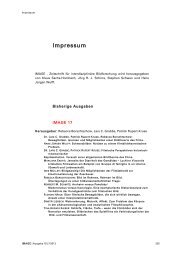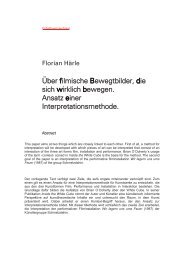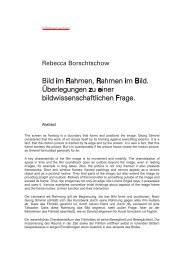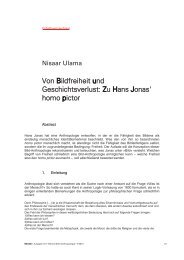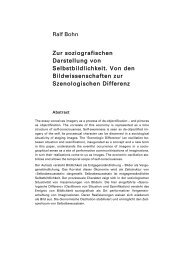Image 4 - Gesellschaft für interdisziplinäre Bildwissenschaft
Image 4 - Gesellschaft für interdisziplinäre Bildwissenschaft
Image 4 - Gesellschaft für interdisziplinäre Bildwissenschaft
Erfolgreiche ePaper selbst erstellen
Machen Sie aus Ihren PDF Publikationen ein blätterbares Flipbook mit unserer einzigartigen Google optimierten e-Paper Software.
MARIO BORILLO/JEAN-PIERRE GOULETTE: COMPUTING ARCHITECTURAL COMPOSITION FROM THE SEMANTICS OF „VOCABULAIRE...--whole/part relations (known as meronomic relations): the purpose of the compositionprocess is to gather in a unit a set of distinct components. The components are ›parts‹of a ›homogeneous‹ whole.--cognitive spatial relations: the spatial relations between objects, such as they arise fromthe interpretation of the language, exceed the framework of the traditional geometry. Asa matter of fact, these relations have to express topological and qualitative informationable to make exactly those distinctions necessary for expressing a relative arrangement ofthe values. Examples in ordinary language are given by the analysis of spatial prepositionlike on (the glass in on the table), at (the box is at the bottom of the wall), (Aurnague,Borillo et al. 1991). These relations do not exactly determine the complete geometry ofthe ob-jects. Only the relevant characteristics of the objects and the relations betweenthem are involved. Their essential function is to induce a structural similarity betweenthe represen-tations and the world represented.--models of composition: they are regular descriptions of architectural compositions (i. e.spatial configurations of architectural elements). These regular descriptions implementrules controlling the relative positions and dimensions of a set of elements that makeup an architectural entity such as defined in the vocabulary of architecture: from theelements to their composition.Starting from the definition of a formal semantics of the elements of the vocabulary, we representthe spatial relations and the principles of composition that arise from the analysis of this specificvocabulary. This first step allows us to compute a process of composition.We will try to test our basic assumption by the analysis of an architectural entity: la baie – the bay. 1In the vocabulary, the bay is a generic term, which indicates the various types of open-ings, withvarious functions, that bear into the walls of our buildings. To study this architec-tural element, werefer to the Vocabulaire de l‘architecture by analyzing the terminological descriptions it gives ofthis architectural object.A conceptual analysis leads us to consider each architectural ›object‹, indicated by a term of thevocabulary, as the association of three meanings, distinct but interdependent: we name them thearchitectural element, its spatial referent, and its geometrical representation. The meanings ofeach component must be considered in the context of the role played by those elements in thecomposition process.--The architectural element belongs above all to the field of the mental representation:it is a cognitive object, an object to think and conceive of a project of architecture,or to describe a building. Its essential characteristic is to be able to be named, to beindicated by a term that is associated to functional and geometrical characteristics (role,arrangement, proportion, morphology …) as we shall see later.--The spatial referent of an architectural element is a ›qualitative‹ object. It results fromthe proper spatial characteristics (topological and geometrical) of the architectural1 Thus, we actually relate in the following on the concept expressed by the French architectural term »la baie« as explained inthe »Vocabulaire de l’architecture«, and use English expressions merely to simplify reading this text.IMAGE I Ausgabe 4 I 7/2006 49



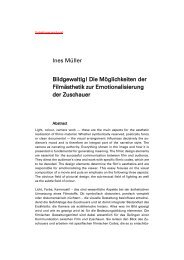
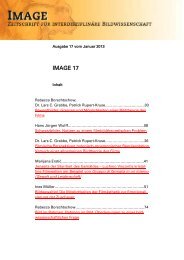
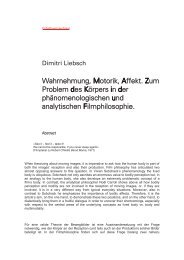
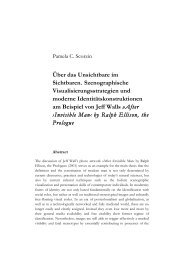
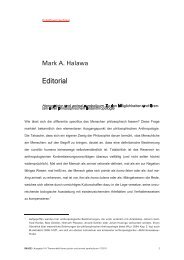
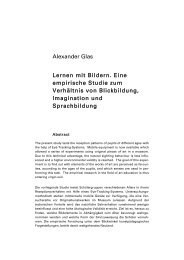
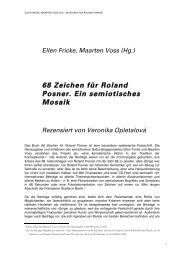
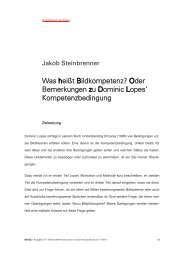
![image 11 [pdf] - Gesellschaft für interdisziplinäre Bildwissenschaft](https://img.yumpu.com/41525154/1/184x260/image-11-pdf-gesellschaft-fur-interdisziplinare-bildwissenschaft.jpg?quality=85)
